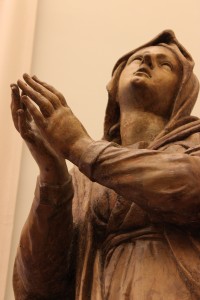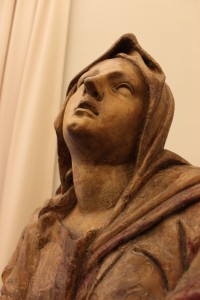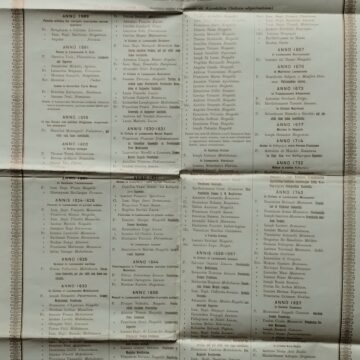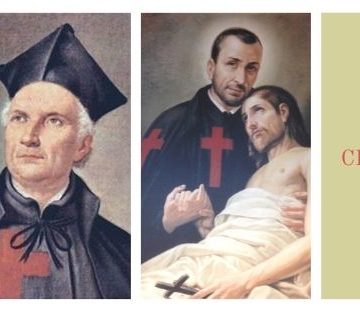 It was the year 1591. On 15 October of the same year Pope Gregory XIV died, the same Pope who by his Motu Proprio had approved and confirmed the Congregation. On 20 October 1591 Pope Innocent IX became the Supreme Pontiff. The greatest wish of Father Camillus was that his Congregation would be raised to being an Order. He was determined to achieve this wish and to make his perpetual profession as soon as possible.
It was the year 1591. On 15 October of the same year Pope Gregory XIV died, the same Pope who by his Motu Proprio had approved and confirmed the Congregation. On 20 October 1591 Pope Innocent IX became the Supreme Pontiff. The greatest wish of Father Camillus was that his Congregation would be raised to being an Order. He was determined to achieve this wish and to make his perpetual profession as soon as possible.
This fundamental moment in the history of the Order is described to us by the first chronicler and biographer of St. Camillus, Fr. Sanzio Cicatelli, who also formed a part of the group of twenty-five companions of Camillus who professed on the same day – 8 December 1591. The manuscript life narrates the episode as follows: ‘Now that it also appeared that the most holy mother of mercies wanted to show to the world that this Congregation had to be completely for her. And given that Camillus was very devoted to St. Michael the Archangel and to St. Francis, he planned to do this on one of those days (p. 143). But the Most Holy Mother of Heaven (by whose intercession Camillus very many years previously had been converted to God on the day of her Purification; on the Assumption he had had his first idea of founding the company, and on the day of Nativity he had begun by dressing his companions) also wanted that he (because of the many impediments that existed because of vacant seats) was delayed from doing this until the day of her Immaculate Conception. This made extremely glad all his companions because of the very strong wish they had to be always under the perpetual protection and most faithful patronage of the always Immaculate Virgin’.
The Founder Saint was very happy that the Immaculate Virgin herself arranged circumstances so that on this occasion she would have the precedence that was hers and which had always be given to her. And this was even more the case given that it was specifically to her that Camillus had addressed special prayers and formal prayers in order to obtain the inspired grace of the perpetual profession of vows.
From this valuable testimony one sees the deep devotion of Camillus first of all, and then of the whole religious Order of the Ministers of the Sick, in recognising the High Patronage of the Mother of God, entrusting themselves fully to her and her protection.
It was thus with transport and veneration that on the morning of 8 December 1591, the ‘day of the most pure conception’, in the Church of St. Mary Magdalene, which was filled to bursting point by the faithful, Camillus made his perpetual profession in front of the Archbishop, and pronounced the following formula: ‘Ego Camillus de Lellis profiteor et solemniter voveo Domino Deo nostro, et tibi Ill.mo Domino (Sanctissimi Domini Nostri ex concessione Apostolica ad hoc speciale munus locum tenenti) coram Sacratissima Virgine eius matre, et universa Curia Coelesti perpetuam Paupertatem, Castitatem, et Obedientiam, et perpetuo inservire (tanquam praecipuum nostri Instituti ministerium) pauperibus infirmis, quos etiam pestis incesserit, iuxta formulam vivendi contentam in Bulla Congregationis Ministrantium Infirmis, ac in eius Constitutionibus auctoritate Apostolica tam editis iam, quam in posterum edendis’.
After making his profession, Camillus himself, on the same day, accepted the professions of his twenty-five companions.
This great devotion to the Virgin continued down the centuries and is still present today. To testify to this it is incumbent to remember that during the twelfth General Chapter of 1655, an authentic Marian congress, it was decreed that every professed had to renew his perpetual vows on the day of the Immaculate Conception. On 8 December of the following year, the Superior General, Fr. Albiti, at a solemn ceremony, consecrated the Order to Our Lady.
The Statute of the Immaculate Virgin
Tradition requires that vows are made in front of the wooden stature of the Immaculate Virgin which appears at the outset to have belonged to the ancient Church of St. Mary Magdalene, together with another statue of Mary Magdalene herself. Given that they could not be taken from the places where they were kept ‘to be transferred and placed in another church, without provoking admiration and not very flattering comments by the faithful, they remained there when the church passed from the hands of the Archconfraternity of the Gonfalon to us’.
Unfortunately, however, no document has been found which attests to the presence of these two statues and the testimony of the earliest biographers make no mention of them.
 Today, after being placed in various locations inside the generalate house, from the General Chapter Hall to the refectory, the statue is on the first floor of the house in the new wing of the St. Camillus Museum which was inaugurated this year on the occasion of the fourth centenary of the death of St. Camillus. For many years it has been placed in the church during the feast day of the Immaculate Mary so that the religious can renew their perpetual vows as it is thought Father Camillus himself and his first companions did.
Today, after being placed in various locations inside the generalate house, from the General Chapter Hall to the refectory, the statue is on the first floor of the house in the new wing of the St. Camillus Museum which was inaugurated this year on the occasion of the fourth centenary of the death of St. Camillus. For many years it has been placed in the church during the feast day of the Immaculate Mary so that the religious can renew their perpetual vows as it is thought Father Camillus himself and his first companions did.
Not even the dating of this statue is certain: it is posited that it was made between the middle and the end of the sixteenth century and seems to have derived from the art of the Caraccis, a family of artists from Bologna.
However, even though this has never been historically ascertained, we like to imagine that Camillus and his twenty-five companions made their first perpetual professions in front of the statue of the Most Holy Queen of Heaven, the Patron Saint and Protector, in heaven and earth, of the Order. It is certainly the case, however, that beyond any documentation in paper form, in the heart of all the sons of St. Camillus it is written that they belong to the Immaculate Virgin.
Bibliography
Vita Manoscritta di P. Sanzio Cicatelli, edited by P. Piero Sannazzaro, pp. 117-120.
Doveva essere tutta sua : la dimensione mariana di S. Camillo de Lellis, Felice Ruffini, pp.144 – 164.
Memorie storiche intorno a S. Camillo de Lellis … : nell’occasione del 3. centenario della morte del santo, 1614-1914, Michele Amici, pp. 105-110.
Per chi volesse continuare la riflessione QUI può scaricare “L’Immacolata” tratto da il Domesticum, Bollettino Storico dell’Ordine, anno 1926 di p. Vanti
















Camillians on Facebook
Camillians on Twitter
Camillians on Instagram